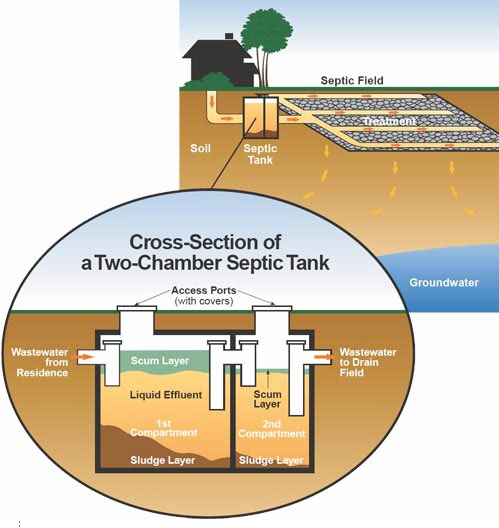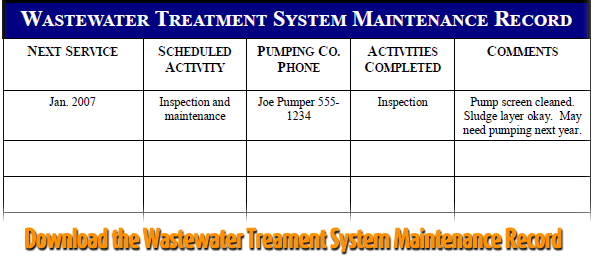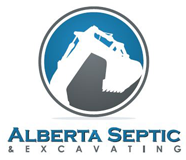|

Designing
Your Private Wastewater Treatment System
In
planning your system, a designer will . . .
- Make a site drawing of your property and evaluate the area available
for a wastewater system.
- Evaluate the soil conditions of your property to determine its
ability to accept wastewater. Under Alberta regulations, the designer
will dig a test pit, take soil samples and determine the soil
texture using lab tests to establish the loading rate.
- Shown on the site drawing will be locations of other utilities
including your well and the location of any public water adjacent
to your property.
- The designer will ask you to supply information on the size
and use of the structures in existence or to be built, and can
only design a wastewater system based on information provided.
- Number of Bathrooms
- Jetted tubs
- Garburetors
- Home based business
- Establish a peak daily flow rate expressed in gallons-per-day
that the system must be able to handle.
Understand
Your new Wastewater Treatment System
Your septic system has two primary components (see Figure
1 below):
Component 1: Septic tank - The septic tank is
a digestion chamber comprised of two steps in which sewage is retained
and effluent is discharged (see Figure 1). The first chamber settles
out the solids producing a sludge layer, which is pumped out after
a certain time period. The second chamber receives the effluent
from the first chamber, which is then stored and intermittently
discharged to an effluent treatment system/drainfield.
Component 2: Treatment Field - A
treatment field system is an effective means of distributing effluent
evenly within a soil-covered trench containing void spaces. Microorganisms
living in the soil then use oxygen in these voids to breakdown the
effluent into safer components. These organisms need 5 ft of suitable
soil below the treatment field according to the Alberta Standard
of Practice.

Figure 1 - Septic field with a two-chamber septic tank.
Gravity distribution versus pressure distribution of effluent
- A gravity distribution system may overload and provide soil microbes
with more food than they can consume. The soil may also become saturated
under a gravity distribution system and is not favourable for aerobic
microbes to treat the sewage. Pressure distribution provides a more
even dispersion of effluent in a disposal field or mound, resulting
in a more effective wastewater treatment and extending the life
of the system.
Tips
for System Longevity
- Do conserve water and spread out water use, you will allow the
time needed to properly separate the wastewater in the working
chamber of the septic tank or treatment plant.
- Don’t shock the system. It is best to prevent large volumes
of water from entering your tank in a short period of time.
- Do have your system inspected (every one to three years) and
pump your tank (as necessary, generally every 18 - 36 months).
- Do use water efficiently.
- Don't dispose of household hazardous wastes, personal hygiene
products, paper towels, cigarette butts, condoms, fats, oils,
and grease in sinks and toilets.
- Do preserve bacterial activity by keeping these bacterial killers
out of your tank: every-flush deodorizers, solvents, over-the-counter
or prescription medications, pesticides, anti-freeze, wash water
from latex paint brushes. Normal amounts of drain cleaners, cleansers,
and bleaches will not harm the bacterial action.
- Do plant only grass over and near your septic system.
Roots from nearby trees or shrubs might clog and damage the treatment
field.
- Don't drive or park vehicles on any part of your septic system.
Doing so can compact the soil in your treatment field or damage
the pipes, tank, or other septic system components.
- Do attach inspection reports and receipts for maintenance to
this package as proof you have maintained your OWTS.
Troubleshooting
Guide
- Sewage backup in building: Serious health risk
- avoid contact with effluent.
Cause: Roots clogging pipes; blockage in plumbing; excess water
from leaky tap; running toilet; pump failure.
Action: Reduce water use; repair taps and toilets; consult a professional
to check pump and possibly clean septic tank.
- Sewage surfacing in yard: Serious health risk
- avoid contact with effluent.
Cause: Excess water entering system; system blockages; improper
system elevations; undersized soil treatment system; pump or controls
failure.
Action: Reduce water use; consult a professional and fence area
until problem is remedied.
- Sewage odour - indoor: toxic gases can cause
discomfort and illness.
Cause: Sewage backup in house; roof vent pipe frozen closed; improper
plumbing; sewage surfacing in yard.
Action: Check and clear roof vent; consult a plumber; consult
a professional to check pump and possibly clean septic tank.
- Sewage odour - outdoors: major nuisance, no
serious health risk.
Cause: Sewage surfacing in yard; inspection pipe cap damaged or
removed; manhole cover partially or fully open; treatment field
is inoperable.
Action: Check caps and replace; immediately replace and secure
manhole; consult a professional to repair or replace treatment
field.
- Pump alarm activated: wastewater may back up
into house, solids may enter treatment field.
Cause: Electrical breaker tripped; pump unplugged; controls malfunctioning;
pump failed.
Action: Check breaker and plugs; consult a professional to check
controls and alarm, replace pump.
- Distribution pipes/soil treatment system freezes in
winter: system may be inoperable.
Cause: Foot or vehicle traffic over piping; improper construction.
Action: Fence off field area, have a professional check construction.
NEVER ENTER
YOUR SEPTIC TANK FOR ANY REASON TOXIC GASES SUCH AS HYDROGEN
SULPHIDE ARE OFTEN PRESENT AND CAN KILL YOU. |
Safety
and Your Wastewater System
- Never enter a tank
You would probably be dead from noxious gases before you reached
the bottom of the septic tank. Extreme care should be taken even
when inspecting or just looking in the tank.
- Keep the tank lid secure
Secure and regularly inspect lids to prevent deliberate or accidental
entry. Keep children and pets away from the tank during servicing
and cleaning.
- Prevent electric shock and explosion
Explosive methane and other gases are produced by your system.
Do not smoke, use electric lights or power tools, or allow flame
or sparks near your septic tank and treatment field.
- Avoid infectious diseases
Contact with the liquid, sludge and scum in the tank may cause
infectious diseases. Wash thoroughly after any contact with your
system.
- Mark the system location and keep heavy vehicles and
equipment off
Do not park, drive or operate any heavy vehicle on your tank or
treatment field.
- Keep fertilizers and flammables out of the system.
The risk of explosion occurs if fertilizers or petroleum products
are placed in your system.
- Smell of sewer gas in your home
If you can smell sewer gas in your home, call a plumber. If the
smell of noxious gases is strong, evacuate the building. A sewer
gas smell outside is a nuisance but normally poses no risk.
PROUD TO BE A MEMBER OF THE
ALBERTA ONSITE WASTEWATER MANAGEMENT ASSOCIATION
Providing all Albertans with
professional service that
protects human health and the environment
For more information visit: www.aowma.com
Handbooks and Standards
of Practice for Private Sewage may be
ordered from the Learning resources Centre Toll Free
province-wide number 310-0000 then 780-427-2767.
|
Download the Wastewater Treatment
System Maintenance Record
Download and print this PDF form and keep track of when you services your septic
tank. Make the most out of your investment.

Reference: Owner’s Manual Alberta Onsite Wastewater Management Association, 2009. http://www.aowma.com/
|


